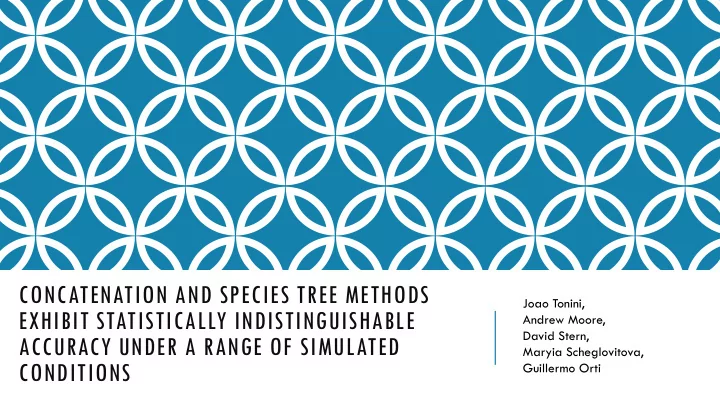

CONCATENATION AND SPECIES TREE METHODS Joao Tonini, EXHIBIT STATISTICALLY INDISTINGUISHABLE Andrew Moore, David Stern, ACCURACY UNDER A RANGE OF SIMULATED Maryia Scheglovitova, CONDITIONS Guillermo Orti
TREE CONCATENATION Differences between gene tree and species tree Average of gene trees = true species tree Incomplete Lineage Sorting Gene Duplication Lateral Gene Transfer Traditional Supermatrix approaches
SPECIES TREE METHODS BATWING STAR BEAST STEAC BEST STEM BUCK SVDdquartets BUCKy STELLS GLASS iGLASS MCMCcoal MDC MP-EST NJst SNAPP
FINDINGS OF PREVIOUS STUDIES There exists species trees for which discordant gene trees are more likely than genealogies that agree with the species tree. - Species trees containing anomaly zones, polytomous gene trees are more probable than anomalous gene trees - Short deep branches, gene trees are more likely to be just uninformative. May still be adequate for densely sampled data matrices under non extreme rates of change Where is the evidence? - Studies proving inconsistencies usually do not prove superiority. - Not reflective of typical empirical studies Mutational Variance Coalescent Variance
HUANG ET.AL Discord is attributed to mutational and coalescent variance Paper concluded that the accuracy of species tree estimation differs systematically depending on - the timing of divergence - the sampling design - the method used for species – tree estimation Using more information contained in gene trees aside from topology such as branch lengths does not translate to gains in accuracy. Accurate species-tree estimation should be dependent on the relative impact of mutational and coalescent variance. Difficulty in estimating impact of mutational variance in the context of species tree estimation.
COMPARISON BETWEEN MDC, STEM, AND CONCATENATION 1) Generating a species tree under a uniform speciation model 2) Simulating coalescent gene trees for each species tree 3) Simulating DNA sequences under a specified model of nucleotide evolution along the branches of each gene tree 4) Estimating gene trees from the simulated DNA matrix 5) Estimating species trees from the estimated gene trees using MDC and STEM 6) Calculating Discord between both trees Simulations do not estimate gene trees separately but estimate directly from concatenated matrixes Comparisons from original Huang paper with identical parameterized simulations under concatenation MDC and STEM were originally chosen for there inputs being gene trees.
SIMULATION 50 species tree of eight taxa from original paper 540 coalescent gene trees foe each of the 50 trees under a neutral coalescent model, constant population size, and no migration using the same script. 1N and 10N generations for gene tree depth Increasing the number of loci in the data matrix to Each gene tree, SEQ-Gen produces 1000 base pairs obtain the true tree with matrices of 3, 9, and 27 HKY model of nucleotide substitution to model evolution genes. Transition and transversion rate ratio of 3.0 540 genes were concatenated into respective matrices Gamma distributed rate heterogeneity shape parameter of producing 180:3 matrices:loci, 60:9, 20:27 0.8 Typical single clock like rate of sequence evolution Dirichlet distributed nucleotide frequencies in accordance with across the tree. Huang.
MRBAYES AND R PHANGOM Ran for each tree estimation until std. deviation < .01 Discarding the first 25% of the posterior results as burn in, 100 trees were sampled from posterior distribution to create the majority rule consensus tree 50% majority rule consensus with compatible clades -Potential problem in clades with polytomous clades -manual inspection of subset of estimated species tree found no polytomous clades Effectiveness of majority rule consensus tree? RF statistic – measuring distance between two unrooted trees for 180, 60, and 20 concatenated matrixes 8-taxon matrices significantly smaller than matrices of most molecular phylogenetic analyses
PHYLOGENETICIST’S TOOLBOX: “NULL” METHODOLOGY Concatenation can outperform well or better than methods that attempt to account for sources of error: -ILS is low -few loci are used -gene trees have low phylogenetic signal Regions of disparity between methods could result from unknown biological factors or critically violated assumptions in either method. Difficult for researchers to know to what extent discordance among gene trees may be due to methodological or sampling error. Criticism for lack of accountability in error due to ILS is reflected by shortcut coalescence methods assuming all error is ILS. Concatenation has practical merit for avoiding making assumptions to which sources of uncertainty influence the evolutionary history of the studied taxa. Concatenation exhibits greater power to overcome sampling error and discrepant patterns of homoplasy and “ concatalescence ” methods can make use of concatenation in improving quality of tree inputs prior to modern coalescence based estimation of species tree.
“ …EXHIBITS STATISTICALLY COMPARABLE ACCURACY UNDER A RANGE OF SAMPLING AND TREE DEPTH CONDITIONS VIS-À-VIS SOME EXISTING SPECIES TREE METHODS, AND URGE MOLECULAR PHYLOGENETICISTS TO THOROUGHLY EVALUATE THE PERFORMANCE OF METHODS THAT MODEL GENE TREE- SPECIES TREE DISCORD AGAINST CONCATENATION ”
QUESTIONS?
Recommend
More recommend